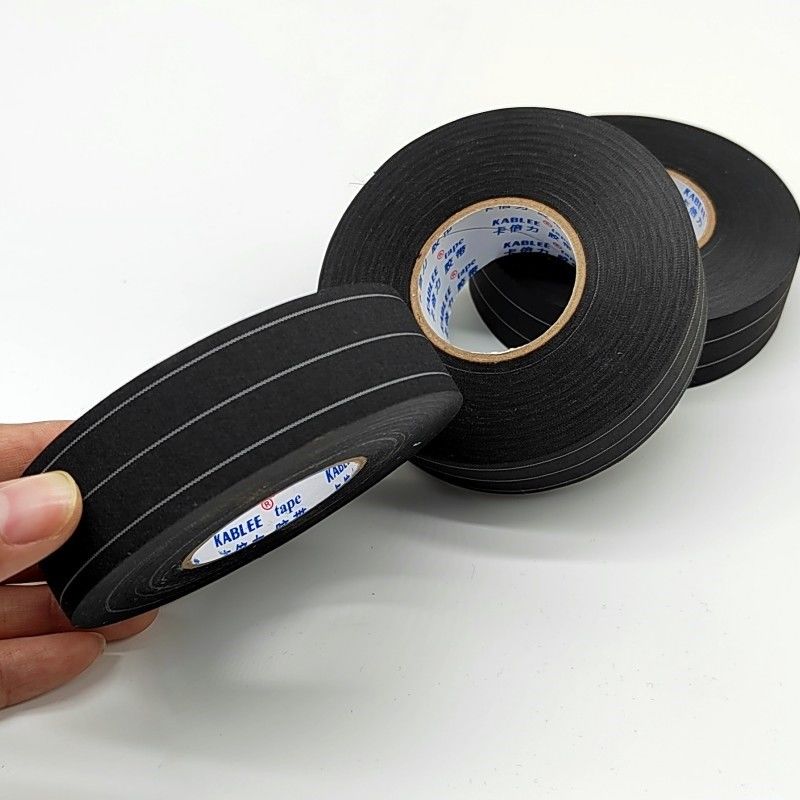Guangzhou Kablee Auto Parts Co., Ltd was founded in Sep. 2013(Kablee Wenzhou in 2006), a professional manufacturer of wire harness tap for automotive with high abrasion resistance and fleece tape with high noise damp, thermal insulation series and Sleeve series. we have top ranking adhesive synthetic technology, advanced manufacturing equipment, rigorous quality management system. Providing solutions for world-famous OEM/harness supplier(Nissan/Infiniti/Mazda/Ford/FCA/GM/Changan/Geely/GAC/Chery/SAIC/Tesla), harness maker(Aptiv/Sumitomo/Yazaki/Furukawa/Lear/PKC).
The main purpose of wire harness tape is to protect the wires and cables from abrasion, moisture, and other external factors that may damage the insulation or conductivity. It provides a layer of insulation and helps to secure the wires in place, preventing them from moving or rubbing against each other.
Wire harness tape is commonly used in automotive, aerospace, and electrical industries. It is often used in wire harnesses, where multiple wires are bundled together, as well as in electrical repairs and installations. The tape is also used to provide additional insulation in high-temperature applications.
Kablee Solution Characteristics:
with performance of noise damp and abrasion resistance
with flexibility and high abrasion
Lower VOC and NVOC
Special adhesive for high temp and thermal shock
Pass RoHS/REACH/ELV standard
Meet OEM growing odor test requirements
Automotive Laminated Tape Technical Diameter:
| Item |
Result |
|
Width
|
19mm±0.20
25mm±0.20
|
|
Thickness
|
0.4mm±0.02
|
|
180°peel-off strength
(under normal condition
|
≥1.5N/cm |
|
180°peel-off strength
(after being heated)
|
≥2N/cm |
|
Tensile strength
(under normal condition)
|
34N/CM |
|
Stretch performance
(under normal condition
|
≥20%
|
|
Tensile strength
(after being heated)
|
35N/CM |
|
Cold resistance
|
no harmful break or crack
|
| Abrasion resistance (Scrape) |
Class D 1000~4999 |
| Flame retardation |
Class B
self-extinguishing |
Wire harness wrapping tape is commonly used in automotive and electrical applications to protect and secure wire harnesses. It provides insulation, abrasion resistance, and helps organize and bundle the wires together. Here's a step-by-step guide on how to apply wire harness wrapping tape:
1. Prepare the wire harness: Ensure that the wires are properly organized and positioned before applying the tape. Remove any dirt, oil, or debris from the harness to ensure good adhesion.
2. Choose the right tape: Select a wire harness wrapping tape that suits your specific needs. There are different types of tapes available, such as cloth tape, vinyl tape, or fleece tape. Consider factors like temperature resistance, flexibility, and electrical insulation properties.
3. Start at one end: Begin the application at one end of the wire harness. Leave a small portion of the tape's adhesive backing exposed to allow for easy removal when necessary.
4. Position the tape: Hold the tape at a slight angle to the wire harness, making sure the adhesive side is facing the harness. Position the tape so that it overlaps the previous wrap by approximately half of its width.
5. Apply tension: Apply gentle tension to the tape as you wrap it around the wire harness. This tension helps create a secure and snug fit. Be careful not to pull too tightly, as it may damage the wires or restrict movement.
6. Overlap and continue wrapping: Continue wrapping the tape around the wire harness, maintaining the overlap and tension. Ensure that each wrap slightly covers the previous one to provide a complete coverage.
7. Smooth out wrinkles and air bubbles: As you wrap, smooth out any wrinkles or air bubbles that may form. This helps ensure a neat and uniform appearance while maximizing the tape's protective properties.
8. Secure the end: When you reach the end of the wire harness, cut the tape, leaving a small portion exposed to facilitate future removal. Press the end firmly to secure it in place

 Your message must be between 20-3,000 characters!
Your message must be between 20-3,000 characters! Please check your E-mail!
Please check your E-mail!  Your message must be between 20-3,000 characters!
Your message must be between 20-3,000 characters! Please check your E-mail!
Please check your E-mail! 
